Sourdough bread has gained massive popularity in recent years, not just for its tangy flavor and chewy texture but also for its perceived health benefits. Among these benefits, there’s a widespread belief that sourdough bread might be gluten-free—or at least lower in gluten—making it safe for those with gluten intolerance or celiac disease. But is this true? Is all sourdough bread gluten-free?
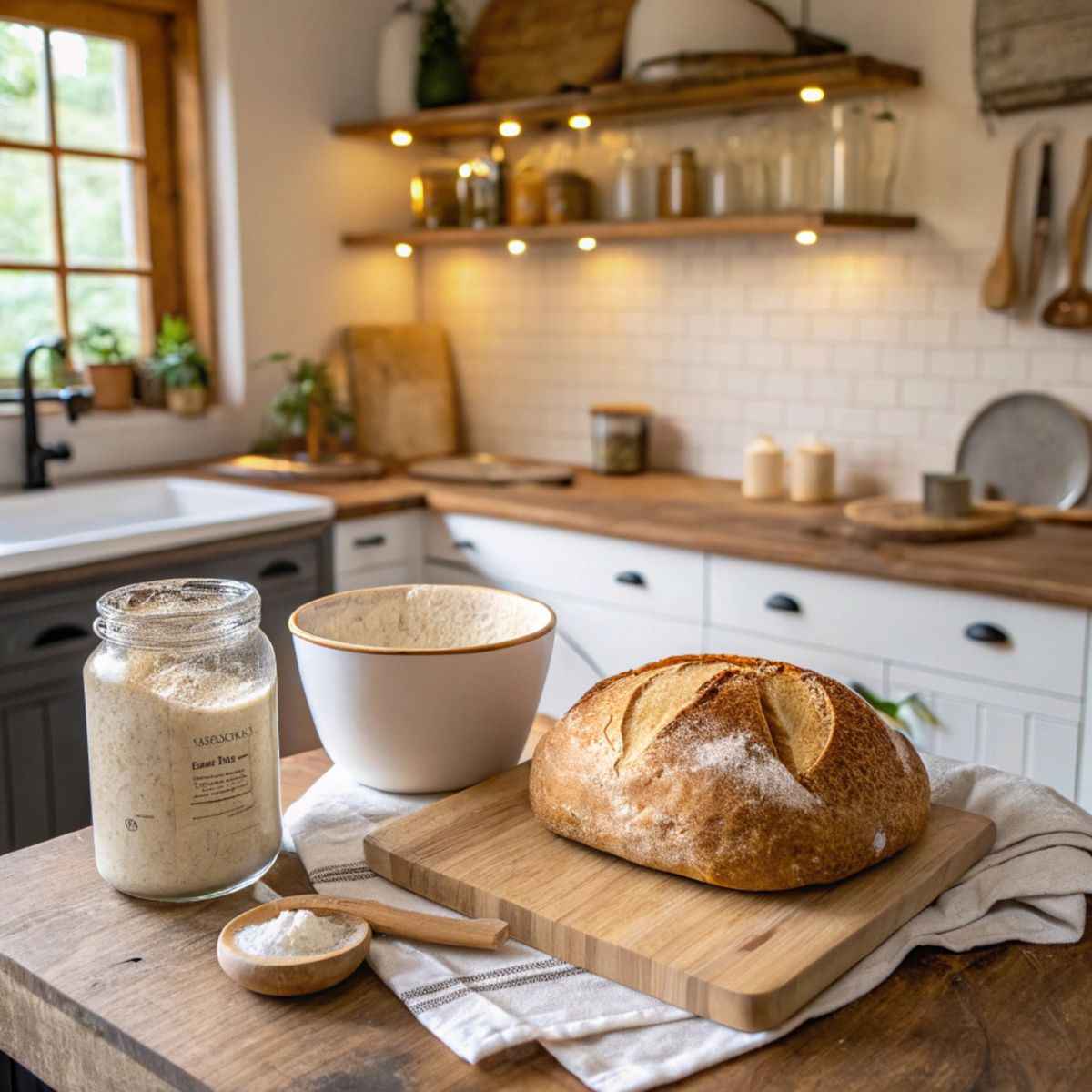
In this guide, we’ll dive deep into the science behind sourdough bread, explore whether it’s naturally gluten-free, and help you identify options that are safe for those avoiding gluten. Let’s unravel the mystery behind sourdough and gluten!
Jump to:
Understanding Sourdough Bread
What Makes Sourdough Bread Unique?
Sourdough bread isn’t your average loaf. It stands out because of its traditional fermentation process, which uses wild yeast and bacteria (lactobacilli) instead of commercial yeast. Here’s what makes it special:
- Fermentation: The wild yeast and bacteria create lactic acid, giving sourdough its distinctive tangy flavor.
- Simple Ingredients: Sourdough typically consists of just flour, water, and salt—no need for additives or commercial yeast.
- Long Rising Time: The slow fermentation allows flavors to develop and makes the bread easier to digest for many people.
This unique process gives sourdough its iconic taste and texture. However, the type of flour used plays a critical role in determining whether it contains gluten.
The Role of Gluten in Bread Making
Gluten, a protein found in wheat, rye, and barley, is essential for creating the structure and elasticity in bread dough. It traps gases produced during fermentation, allowing the bread to rise and maintain its shape. Without gluten, bread can be dense and crumbly.
In sourdough bread, the fermentation process partially breaks down gluten, making it easier for some people to digest. However, it’s crucial to note that sourdough made with wheat flour still contains gluten, even if the levels are slightly reduced.
Gluten and Sourdough: The Truth
The relationship between sourdough bread and gluten can be confusing. Many people assume that the fermentation process removes gluten entirely, but this isn’t entirely accurate. Let’s explore the facts.
Does Fermentation Reduce Gluten Content?
The fermentation process used in sourdough bread does, indeed, affect gluten levels—but it doesn’t eliminate gluten. Here’s how it works:
- Partial Breakdown of Gluten: During fermentation, the wild yeast and bacteria break down some of the gluten proteins. This is why sourdough is often considered easier to digest compared to regular bread.
- Reduced Gluten Doesn’t Mean No Gluten: While gluten levels may be lower, they are not reduced to the point where the bread becomes safe for people with celiac disease or severe gluten sensitivity.
Studies have shown that traditional sourdough bread made with wheat flour still contains measurable amounts of gluten, which can trigger adverse reactions in those with gluten-related disorders.
Is Sourdough Bread Naturally Gluten-Free?
This is one of the biggest misconceptions about sourdough bread. Here’s the truth:
- Wheat-Based Sourdough: Traditional sourdough bread is made from wheat, rye, or barley—all of which naturally contain gluten. Even though fermentation reduces gluten to some extent, it’s far from gluten-free.
- Gluten-Free Sourdough Options: There are gluten-free sourdough breads made with alternative flour like rice, buckwheat, or sorghum. These are specially formulated to be safe for individuals with celiac disease or gluten intolerance.
Love learning about gluten-free options? Don’t miss my guide on Gluten-Free Sourdough Starter for bakers looking to master the art of gluten-free bread.
For those with strict dietary restrictions, it’s essential to look for bread specifically labeled as “gluten-free sourdough” to avoid any risk of cross-contamination or hidden gluten.
How to Identify Gluten-Free Sourdough
Finding a truly gluten-free sourdough bread can be tricky, especially with so many varieties available. However, knowing what to look for can make the process much simpler.
Ingredients to Look For
The first step in identifying gluten-free sourdough is checking the ingredients. Here’s what to keep in mind:
- Safe Grains for Gluten-Free Sourdough:
- Rice flour: A common base for gluten-free bread.
- Buckwheat flour: Despite its name, buckwheat is gluten-free and lends a hearty flavor.
- Sorghum flour: Adds structure and mild sweetness.
- Tapioca or potato starch: Helps mimic the elasticity of gluten.
- Avoid These Gluten-Containing Ingredients:
- Wheat flour (including whole wheat and spelled)
- Rye
- Barley
- Oats (unless specifically labeled gluten-free)
Some recipes may also include additives or flavorings that could contain hidden gluten, so a thorough check of the label is crucial.
Looking for a foolproof recipe? Check out my Gluten-Free Bread Recipe for soft, delicious loaves that are easy to make.
Certifications and Labels
When shopping for gluten-free sourdough, certifications and labels can provide reassurance. Here’s what to look for:
- Certified Gluten-Free Seal: Products with this label have been tested and meet strict standards for gluten-free certification (usually containing less than 20 parts per million of gluten).
- Allergen Statements: Look for a statement like "produced in a gluten-free facility" to minimize risks of cross-contamination.
- Ingredients Panel Clarity: Avoid bread with ambiguous terms like “natural flavors” or “spices” unless confirmed to be gluten-free.
Ask Questions at Local Bakeries
If you’re buying sourdough from a local bakery, don’t hesitate to ask questions. Key points to clarify include:
- The type of flour used in the bread.
- Whether the bread was made in a dedicated gluten-free kitchen.
- Measures taken to avoid cross-contamination.
Making Gluten-Free Sourdough Bread
Making gluten-free sourdough bread at home is a rewarding process, and it ensures that your bread is entirely free from gluten contamination. With the right ingredients and technique, you can bake a loaf that rivals traditional sourdough in flavor and texture.
Can You Make Gluten-Free Sourdough at Home?
Absolutely! Baking gluten-free sourdough bread requires a few specialized ingredients, but it’s easier than you might think. The key steps include creating a gluten-free sourdough starter and mastering the dough-making process.
Ingredients for a Gluten-Free Sourdough Starter
A sourdough starter is the heart of your bread, and making one gluten-free is simple. You’ll need:
- Gluten-Free Flour: Brown rice flour, sorghum flour, or a blend.
- Filtered Water: Chlorine in tap water can inhibit fermentation.
- A Glass Jar: For mixing and storing your starter.
If you’re ready to start baking, my article on Gluten-Free Sourdough Starter will guide you step by step.
Step-by-Step Process for Baking Gluten-Free Sourdough
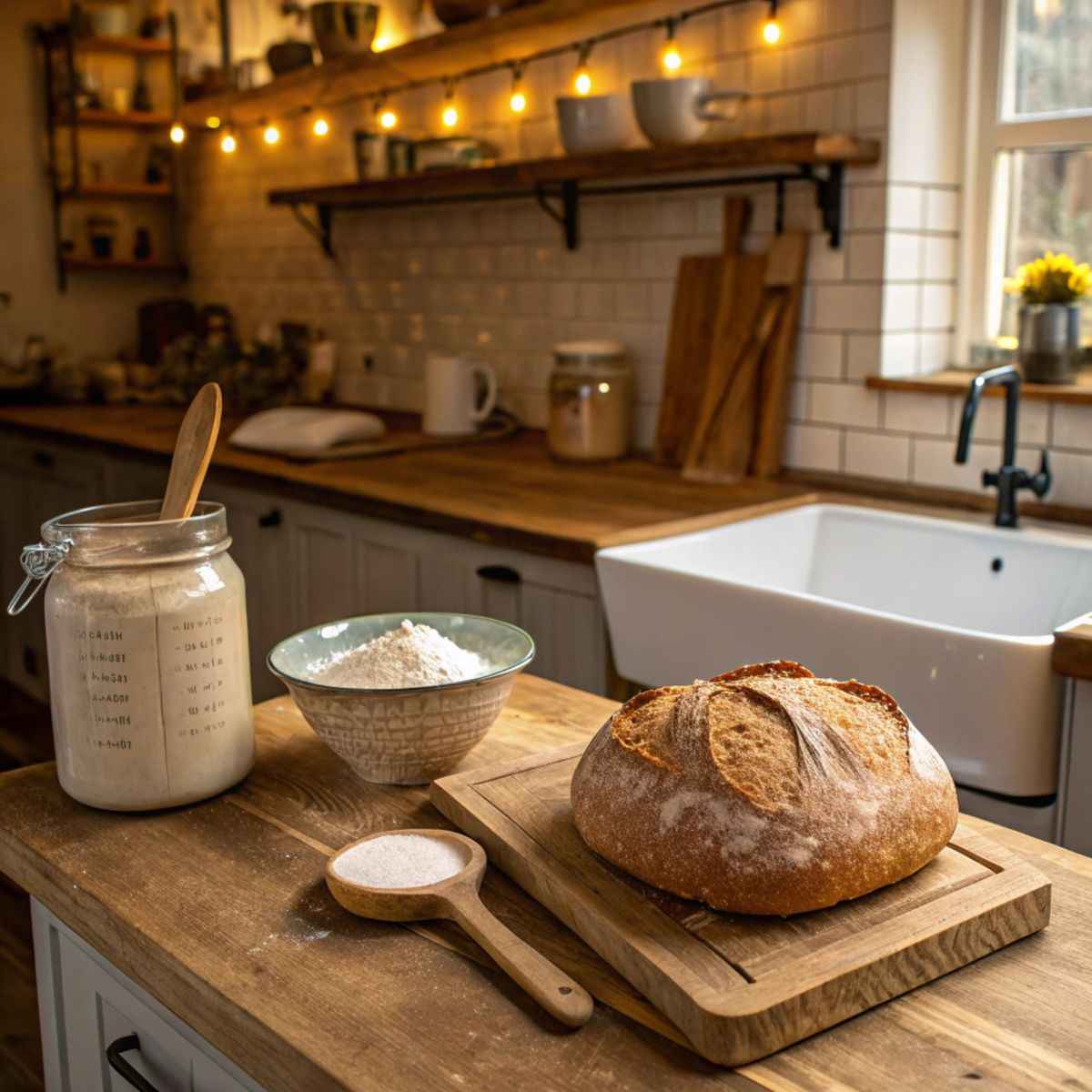
Make the Starter
- Mix equal parts gluten-free flour and filtered water in a jar (e.g., ½ cup of each).
- Stir thoroughly, cover loosely, and leave at room temperature.
- Feed the starter daily by discarding half and replenishing it with fresh flour and water.
- After 5–7 days, the starter should be bubbly and smell tangy—this means it’s ready to use!
Prepare the Dough
- Combine your gluten-free starter with a mix of gluten-free flour (e.g., rice, tapioca, and potato starch).
- Add water, salt, and optional ingredients like olive oil or honey.
- Mix thoroughly until the dough is sticky but holds its shape.
Proof the Dough
- Shape the dough and place it in a loaf pan or proofing basket.
- Cover it and let it rise for 4–6 hours, depending on the room temperature.
Bake the Bread
- Preheat the oven to 450°F (232°C).
- Bake for 35–45 minutes, or until the crust is golden brown and the bread sounds hollow when tapped.
Tips for Success
Troubleshooting Common Issues
- Starter Not Bubbling: Ensure you’re using gluten-free flour and filtered water. Patience is key!
- Dough Too Dense: Add a small amount of xanthan gum or psyllium husk for elasticity.
- Bread Too Crumbly: Increase hydration or add starches for a softer texture.
Achieving the Best Flavor
- Use your starter at peak activity for a tangier loaf.
- Experiment with fermentation times to find the flavor balance you love.
Popular Brands Offering Gluten-Free Sourdough
If you’re not ready to dive into baking your gluten-free sourdough, don’t worry—several brands offer high-quality options that are both delicious and safe for those avoiding gluten. Here’s a roundup of some popular gluten-free sourdough bread brands and where to find them.
Top Gluten-Free Sourdough Brands
1. Bread Srsly
- Why It Stands Out: Bread Srsly is a highly regarded brand offering authentic, tangy gluten-free sourdough. It’s made with organic ingredients and is free from top allergens like dairy, nuts, and soy.
- Key Features: Certified gluten-free, vegan, and fermented for a distinctive sour flavor.
- Best Seller: Classic Gluten-Free Sourdough Loaf.
2. New Grains Gluten-Free Bakery
- Why It Stands Out: Known for its soft texture and classic sourdough tang, New Grains Gluten-Free Bakery produces bread that appeals to both gluten-free and non-gluten-free eaters.
- Key Features: Certified gluten-free, made in a dedicated gluten-free facility.
- Best Seller: Gluten-Free San Francisco Style Sourdough.
3. Simple Kneads
- Why It Stands Out: Simple Kneads offers artisanal sourdough loaves crafted from nutrient-dense, gluten-free grains like buckwheat and quinoa.
- Key Features: Non-GMO, free from dairy and soy, and made with whole grains for added fiber.
- Best Seller: Quinoa Power Grains Sourdough.
Where to Buy Gluten-Free Sourdough Bread
Online Stores
Many gluten-free bread brands sell their products directly through their websites or major online retailers like Amazon. Some popular options include:
- Bread Srsly (www.breadsrsly.com)
- Simple Kneads (www.simplekneads.com)
- Thrive Market (www.thrivemarket.com)
Local Health Food Stores
Stores like Whole Foods Market, Sprouts Farmers Market, and specialty gluten-free shops often carry popular brands of gluten-free sourdough.
Bakeries Specializing in Gluten-Free Products
Local bakeries dedicated to gluten-free baking may offer fresh gluten-free sourdough in some cities. Always inquire about their processes to ensure cross-contamination is avoided.
FAQs
To address some of the most common questions about sourdough bread and its gluten-free variations, here are concise and helpful answers.
No, regular sourdough bread made with wheat, rye, or barley contains gluten and is not safe for people with gluten intolerance or celiac disease. While fermentation may reduce gluten levels slightly, the remaining gluten can still cause adverse reactions.
Gluten-free sourdough has a slightly different texture compared to traditional sourdough. It may be denser and less elastic due to the absence of gluten. However, the tangy flavor is often comparable, especially when a gluten-free sourdough starter is used.
No, people with celiac disease should avoid regular sourdough bread unless it’s specifically made with certified gluten-free ingredients. Consuming gluten, even in small amounts, can damage the intestinal lining of individuals with celiac disease.
Yes, there is a potential risk of cross-contamination, especially if the bread is made in a facility that also processes gluten-containing products. To ensure safety, look for products labeled as “certified gluten-free” and made in a dedicated gluten-free facility.
Gluten-free sourdough bread typically lasts 3–5 days at room temperature when stored in an airtight container. For longer storage, it can be frozen for up to 3 months. Always check the packaging for specific storage recommendations.
Conclusion
Sourdough bread is beloved for its unique flavor, digestibility, and traditional fermentation process. However, the idea that all sourdough bread is gluten-free is a misconception. Regular sourdough bread made from wheat, rye, or barley still contains gluten, even if fermentation reduces its levels slightly.
For those with gluten intolerance or celiac disease, it’s essential to stick to certified gluten-free sourdough options. Whether you buy from trusted brands or bake at home, always verify the ingredients and production methods to ensure safety.
By understanding the differences and knowing what to look for, you can enjoy the tangy goodness of sourdough without compromising your dietary needs.
Curious about all things gluten-free? Discover the types, benefits, and baking tips in my post on Gluten-Free Bread Explained.
Wondering if your favorite treats are safe? Check out Are Marshmallows Gluten-Free? for everything you need to know.

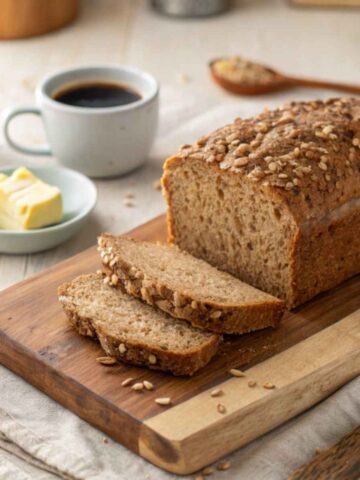

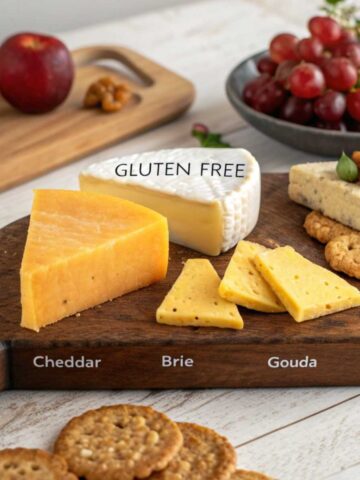
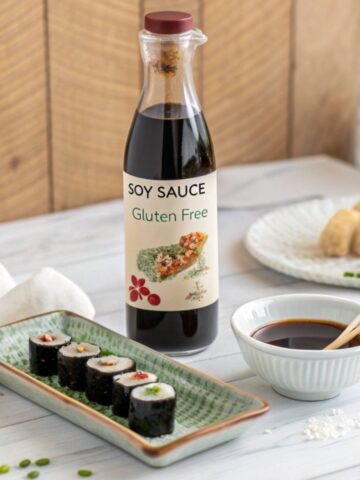
Leave a Reply